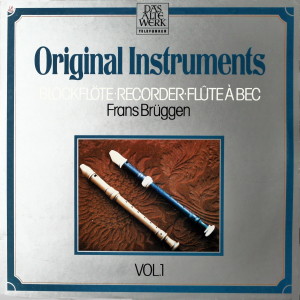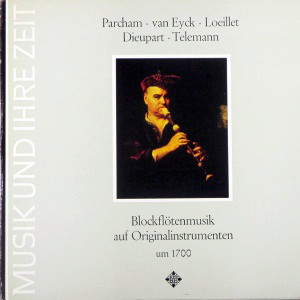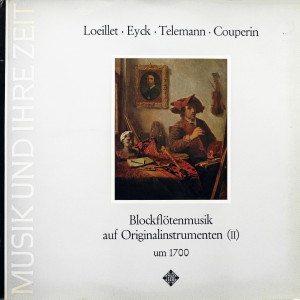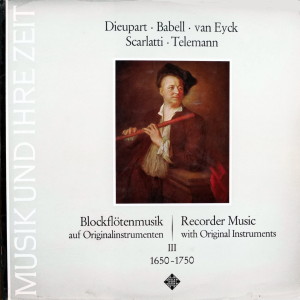 |
1 LP -
Telefunken 6.42050 AP (p) 1966/1972
|
|
| ORIGINALINSTRUMENTE - Blockflöte
· Recorder · Flûte à bec |
|
|
|
|
|
|
|
| Jacob Jan van Eyck (um
1590-1657) |
Vier
Figurationen über John Dowlands
"Pavan Lacrimae" für Blockflöte
solo *
|
|
10' 05" |
A1 |
| Andrew Parcham (vor
1700) |
Solo
für Blockflöte und Bass continuo
G-dur **
|
|
7' 10" |
A2 |
| Robert Carr (17.
Jh.) |
Division
upon an Italian Ground - aus
"The Delightful Companion", für
Alt-Blockflöte und Basso continuo
***
|
|
2' 35" |
A3 |
| Jacob Jan van Eyck |
Engels
Nachtegaeltje, für
Blockflöte solo
****
|
|
5' 40" |
B1 |
|
Variationen
über "Doen Daphne d'over schoone
Maeght" *****
|
|
8' 30" |
B2 |
| Johann Christoph Pepusch
(1667-1752) |
Sonate
Nr. 4 F-dur für Alt-Blockflöte und
Basso continuo ******
|
|
6' 56" |
B3 |
|
-
Adagio · Allegro · Adagio · Giga |
|
|
|
|
|
|
|
|
| Frans
BRÜGGEN |
mit |
|
-
Sopran-Blockflöte in c" von
Terton, Frankreich, Ende 17. Jh.
*
|
Nikolaus
Harnoncourt, Viola da
gamba ** |
|
-
Alt-Blockflöte in f' von van
Aardenberg, Niederlande, um 1700
**
|
Anner
Bylsma, Violoncello |
|
-
Alt-Blockflöte in f' von R. Wijn,
Nijmegen ***
|
Gustav
Leonhardt, Cembalo |
|
-
Sopran-Blockflöte in c" von
Richard Haka, Amsterdam, ca. 1685
****
|
|
|
| -
Sopran-Blockflöte in c"
von W. Beukers *****
|
|
|
-
Alt-Blockflöte in f' von van
Heerde, Holland ******
|
|
|
|
|
|
|
Luogo
e data di registrazione |
|
Bennebroek
(Olanda) - aprile e maggio 1969
(van Eyck, Carr, Pepusch)
|
|
|
Registrazione:
live / studio |
|
studio |
|
|
Recording
Supervision
|
|
-
|
|
|
Edizione LP |
|
TELEFUNKEN
- 6.42050 AP - (1 LP - durata 40'
56") - (p) 1966 */** 1969
***/*****/****** & 1972 **** -
Analogico
|
|
|
Originale LP
|
|
TELEFUNKEN - SAWT
9482-A - (1 LP - durata 48' 01")
- (p) 1966 - Analogico (van
Eyck, Parcham)
TELEFUNKEN - SAWT 9545-A - (1 LP
- durata 41' 45") - (p) 1969 -
Analogico (Carr, van Eyck,
Pepusch)
TELEFUNKEN - SAWT 9582-A - (1 LP
- durata 52' 43") - (p) 1972 -
Analogico (van Eyck)
|
|
|
Prima Edizione CD |
|
TELDEC "Frans
Brüggen Edition" Vol. 4 -
4509-97466-2 - (1 CD - durata
58' 32") - (c) 1995 - ADD (van
Eyck)
TELDEC
"Frans Brüggen
Edition" Vol.
3 -
4509-97465-2 -
(1 CD - durata
64' 20") - (c)
1995 - ADD
(Parcham,
Carr, Pepusch)
|
|
|
Note |
|
Long
playing compilation.
|
|
|
|
|
   |
This
selection of
recorders from a
few of the large
number of woodwind
makers working in
Holland at the end
of the 17th
century and the
beginning of the
18th shows less of
a peculiarly
national
characteristic
than would be the
case if such a
selection were to
be made from, say,
the English or
German instruments
of the same
period. Rather,
there is an
independence which
may perhaps
equally be viewed
as a national
characteristic,
but which did not
result in a
consistently
identifiable
character in the
recorders produced
by these makers.
Instead, the
instruments show
some
individuality,
with variety in
both tonal quality
and compass, and
also in the form
of the tumery.
As there are
elements in the
design of a
recorder which
relate
specifically to
compass, tonal
behaviour, and
quality of sound,
the variety of
form seen in these
Dutch recorders
provides the
possibility of
isolating to some
extent the causes
of their musical
individuality.
The physical
reasons for the
compass and sound
quality of a
particular
recorder type can
be found mainly in
the profile of the
internal bore, and
the size, placing,
and undercutting
of the finger
holes. However,
the basic
dimensions and
adjustment of the
windway surfaces
and labium play a
very large part in
establishing the
fmal quality of
the tone dictated
in the first place
by the bore of the
instrument.
The first
instrument, the
soprano recorder
by E. Terton, has
the full Baroque
recorder compass
of c" - d"",
together with a
firm clear tone.
The windway and
labium are of
normal width, but
the sides of the
window are much
higher than usual
due to the very
thick walls of
this instrument.
The increased wall
height gives a
full and edgy
quality to the
sound.
The soprano by
Richard Haka,
while it also has
the full compass
of the Terton, has
a much gentler
tone. This is
partly due to the
lower window sides
which result from
thinner walls at
the block line and
a nearly straight
labium, but of
even greater
importance is the
smaller than usual
jet length (the
distance from
windway to
labium).
The W Beukers
soprano has a
narrower compass,
c" - roughly a'",
but has very large
voicing
dimensions. This
gives a strong
tone of less
subtlety than
either the Terton
or the Haka, but
rather more
vigorous in its
effect. The Wijne
alto, with its
very small
voicing, has a
tone of quite
unusual
gentleness, but
with the full alto
compass.
The remaining two
instruments, altos
by van Heerde and
van Aardenberg,
also have the
limited compass of
f' - d'". However,
the fine
adjustment of the
block/labium
relation gives
them a full,
clear, and
responsive sound.
The peculiarities
of bore which
cause the smaller
compass also give
the second lowest
note a very round,
firm, and clear
tone.
Frederick
Morgan
|
|
|
|

